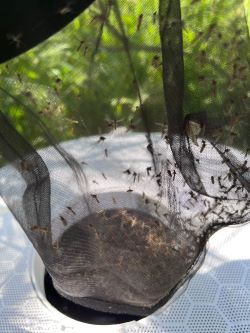Researchers from the Doñana Biological Station – CSIC, the University of Granada and Bioparc Fuengirola has analysed the presence of avian malaria parasites in three species of mosquitoes.
The Asian tiger mosquito, an invasive species, does not seem to have a critical function in the transmission of this disease.
A research team from the Doñana Biological Station – CSIC, the University of Granada and Bioparc Fuengirola has analysed using molecular techniques the presence of avian malaria parasites in three mosquito species: the common house mosquito (Culex pipiens), the species Culiseta longiareolata and the Asian tiger mosquito (Aedes albopictus). Avian malaria parasites were not found in the latter ones, but the analyses were positive in the common house mosquito. The study has been carried out in Granada and Malaga, in southern Spain, and has been published in the scientific journal Parasite & Vectors.
"These results suggest that, in southern Spain, the Asian tiger mosquito is less relevant in the transmission of avian malaria than other native species," explains Marta Garrigós, first author of the study and researcher at the University of Granada. The Asian tiger mosquito is considered one of the most harmful invasive species in the world, for its capacity for adaptation and transmission of different parasites. However, according to these results, its role as an avian malaria vector is less important than the role of the common house mosquito.
In the present, the Asian tiger mosquito has stable populations in several European countries. In Spain, the species has gradually colonized new areas, and there have been stable populations in these Andalusian provinces since the last decade. "The main food source for Asian tiger mosquitoes is mammals. This could explain that it has not a relevant role in the transmission of avian malaria," says the researcher.
A disease affecting from sparrows to raptors
Avian malaria is a disease produced by parasites that are transmitted through mosquito bites from infected birds to other birds. "This disease affects most bird species around us, from different environments and different groups, from sparrows to raptors," explains Josué Martínez de la Puente, researcher at the Doñana Biological Station – CSIC.
Besides the relation of these parasites to the human malaria, they are not capable of infecting humans. They do produce negative effects on birds' health status, as well as their survival probability and reproductive success. Recent studies have demonstrated the contribution of these parasites to the declination of common bird species, such as the sparrow, and native species in some areas, such as Hawaii, where parasites were introduced.
"Changes in the distribution of the common house mosquito by processes, for instance, linked to global change, can increase the exposure of birds in some territories to the parasites they can transmit", explains the researcher. "Avian malaria parasites naturally circulate in the environment and offer a natural study model to look into the dynamics of pathogens transmission in nature", he concludes.
The results have been obtained in the context of the projects Microvec (PID2020-118205GB-I00) y AedesMicrobiota (CNS2022-135993) de la Spanish Research Agency (Agencia Española de Investigación) of the Spanish Ministry of Science, Innovation and Universities and offer preliminary knowledge on the epidemiological consequences of the invasive Asian tiger mosquito Aedes albopictus. The research team continues studying on this line with the aim of knowing its potential as vector of different pathogens causing diseases on both humans and wildlife.
Reference
Marta Garrigós, Jesús Veiga, Mario Garrido, Clotilde Marín, Jesús Recuero, María José Rosales, Manuel Morales-Yuste, Josué Martínez-de la Puente. 2024. Avian Plasmodium in invasive and native mosquitoes from southern Spain. Parasites & Vectors 17: 40. https://doi.org/10.1186/s13071-024-06133-8
https://doi.org/10.1186/s13071-024-06133-8


 El mosquito común, clave en la transmisión de la malaria aviar
El mosquito común, clave en la transmisión de la malaria aviar
